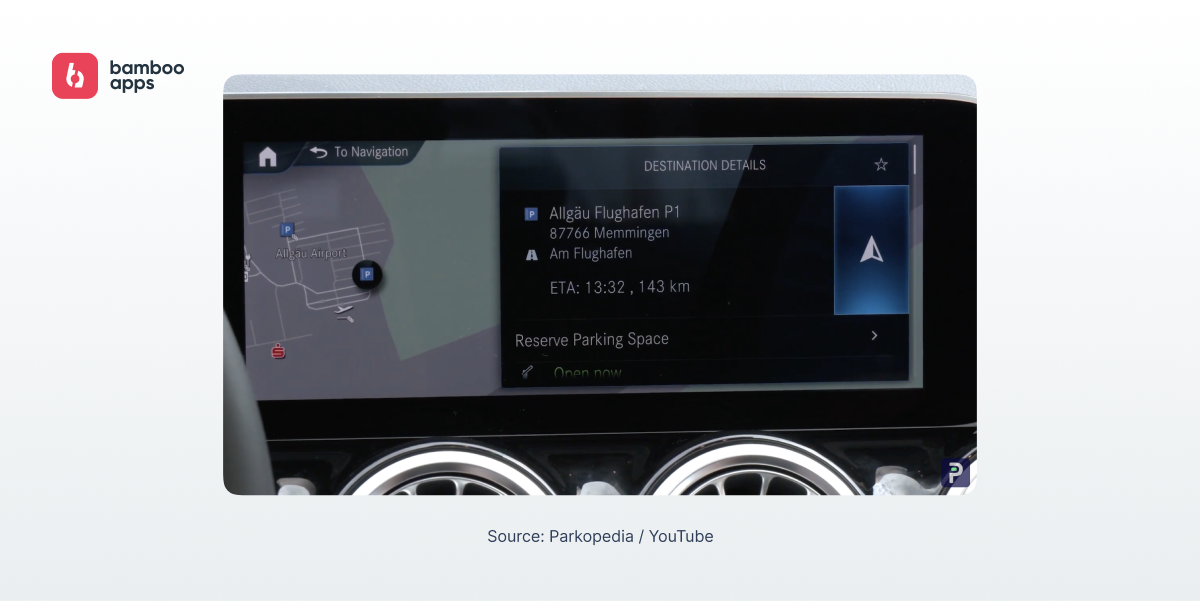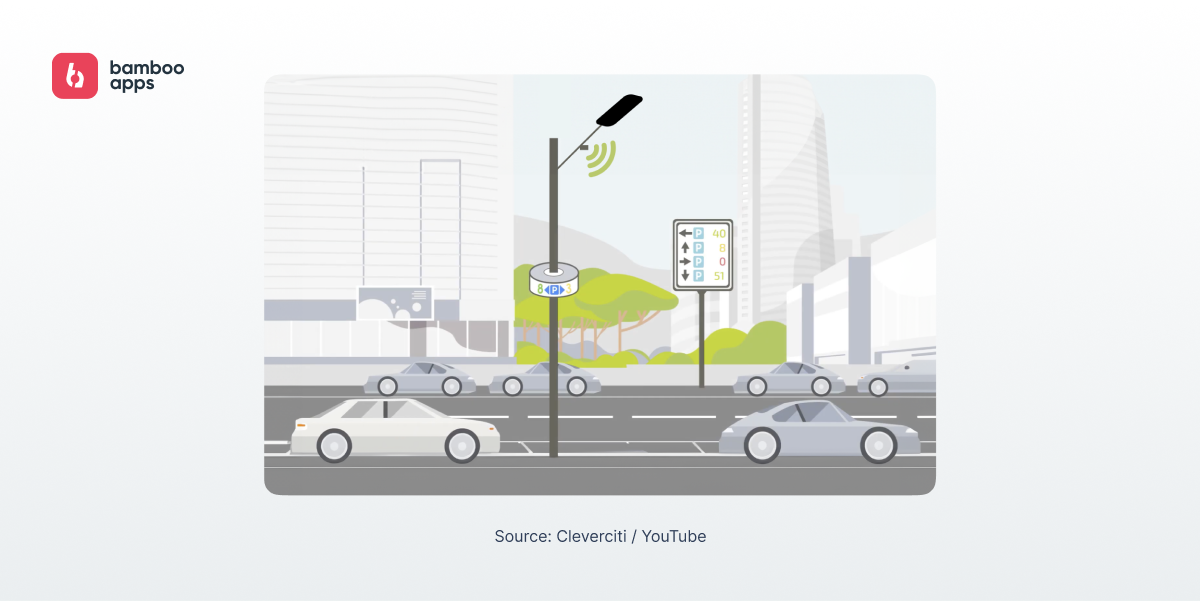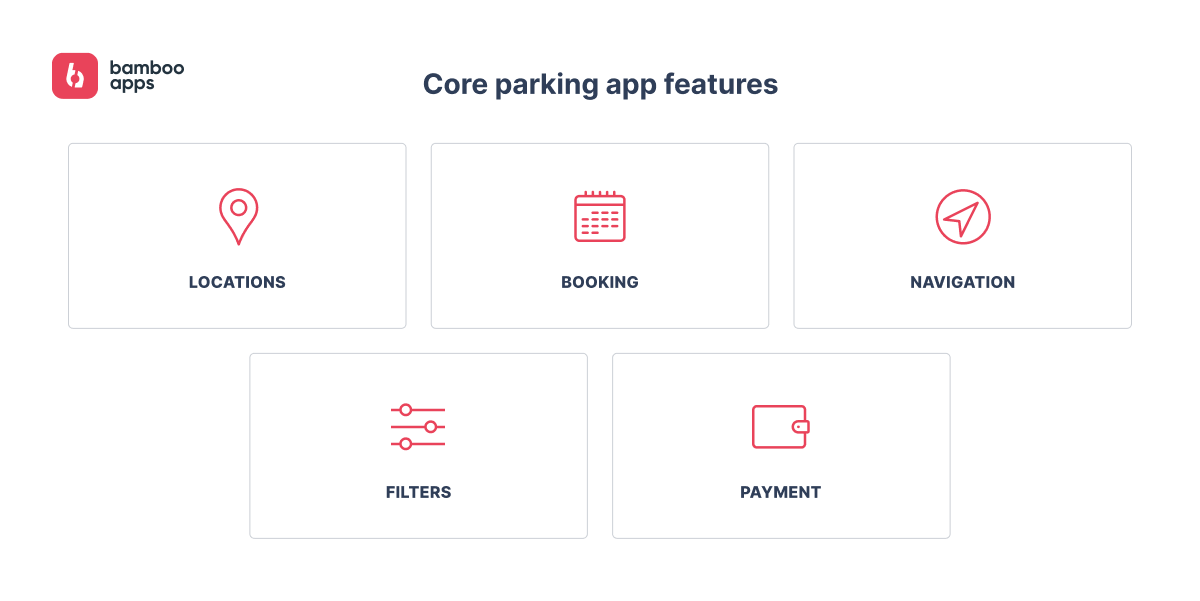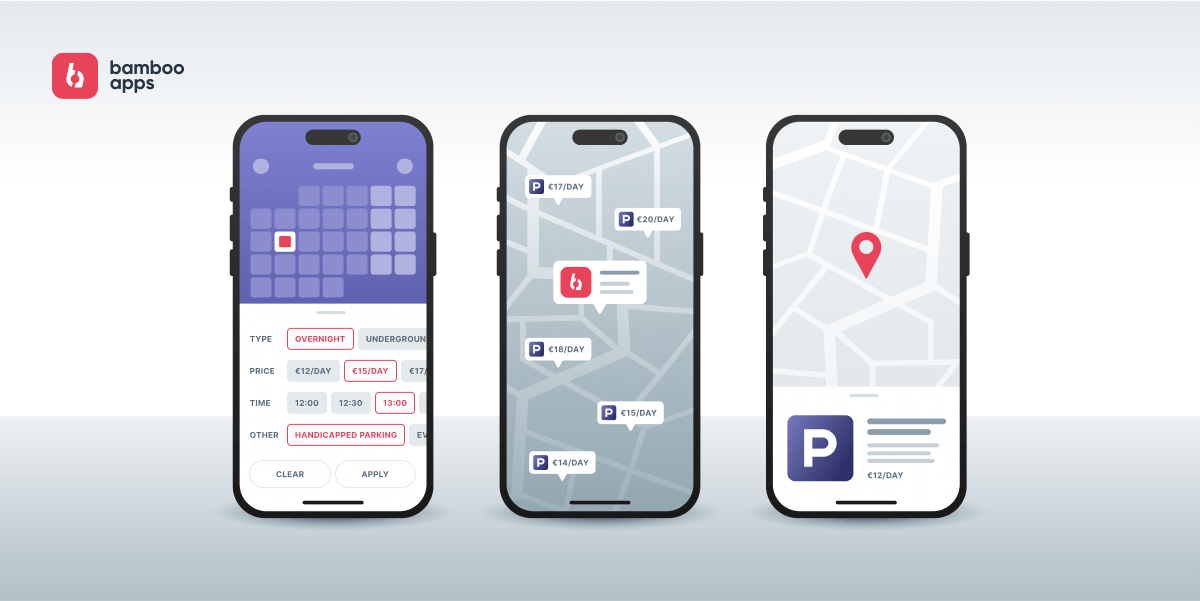- Introduction
- How parking apps have changed over time
- What features a parking app should have
- The parking app features mostly demanded in 2024
- Ideas for unique features
- How to create a parking app
- Latest trends in parking app design (UX solutions)
- How Bamboo Apps can help with parking app development
- Conclusion
- FAQ
Introduction
As urbanisation continues to surge, finding a parking spot in big cities has become a challenge. Just imagine this: finding a vacant spot can take up to 30 minutes and 4.5 kilometres daily. Almost a day in life spent looking for a parking spot each month! Not only does it cost time – it also increases fuel expenses and raises emission levels.
The solution? Parking apps. The market for smart parking is accelerating its exponential rise. In 2023, its projected value was $8.1 billion. By 2030, it is anticipated to increase at a compound annual growth rate (CAGR) of more than 13%.
This is why creating a parking app in 2024 is not just a good idea – it is a great one. And if you want to know how to create a parking app, this blog article by Bamboo Apps’ experts will provide you with all the necessary information and feature ideas.
How parking apps have changed over time
Initially, the main purpose of parking apps was to assist drivers in locating open parking spots. With a focus on user-generated data and simple mapping technology, these early iterations were limited in scope.
But with the growing popularity of connected vehicles and smart cities, parking apps have evolved, too. Let us take a look at various outcomes for this.
Given the era of connected vehicles
Nowadays, parking applications can work directly with connected vehicles to offer powerful parking assistance. The app receives real-time data from the car’s sensors and systems. This allows its users to do the following:
- Find the closest available spot and get navigation instructions to it
- Pay for parking automatically on arrival
- Receive alerts when a parking session is about to expire
- Extend time remotely if necessary.
A good example of this is Parkopedia’s integration with the European model of Mercedes-Benz B Class. It allows drivers to find and pay for a parking spot in the car’s infotainment system. The parking pass is available in the companion smartphone app.

Furthermore, connected vehicles help apps provide features like customised parking recommendations, automatic entrance and exit, and even predictive availability based on user behaviour.
With the emergence of smart city solutions
Smart city solutions have further enhanced parking apps’ capabilities. IoT-enabled sensors embedded in parking spaces are already common in many urban locations, offering real-time data on space occupancy. By interacting with parking apps, these sensors provide users with timely information about available spaces.
Cleverciti, a smart city mobility company, provides such services for parking. It uses overhead sensors to provide data on available parking spaces. On arrival, drivers are guided to the nearest free parking lot. Cleverciti employs digital signs that combine parking data with navigation information.

Smart city solutions help more than just drivers; they also give city planners useful information to improve traffic flow and parking management. They can improve traffic conditions, modify parking rules, and increase general urban mobility by analysing sensor data. The integration of parking apps with smart city infrastructure is contributing to the goal of more sustainable and effective urban living.
Given the focus on sustainability
Urban planning is placing an emphasis on sustainability. Yet, locating charging stations that are open to electric vehicle (EV) drivers can be a difficult task. To solve this, modern parking apps offer information on the locations and availability of EV charging stations.
This feature is available in multiple parking apps. For example, Parkopedia aggregates data from various charging providers in one interface. Then, it combines parking and charging information, giving drivers an opportunity to find EV charging stations at parking spots, as well as authorise and pay for charging sessions inside the app. RingGo, a popular UK parking app, has a built-in map of EV charging stations.
To further promote the usage of EVs, certain cities also provide reduced parking costs for them. These promotions can be integrated into parking apps, which will show affordable parking possibilities for eco-friendly cars. These apps aid in the reduction of urban pollution and the promotion of sustainable mobility efforts.
What features a parking app should have
So you have decided you want to create a parking app. The next logical step is understanding the features you need to include in it.
At Bamboo Apps, we suggest the following typical features as the basis of your parking app.
- Locations. This is a must-have feature for any parking application. Your app’s users should be able to pinpoint the exact locations of open spots, including garages, private lots, and streets.
- Booking. Some apps help their users secure a treasured spot ahead of time. This is especially helpful for busy areas, such as airports or event venues.
- Navigation. A good parking app should seamlessly integrate with the smartphone’s GPS. Once the app locates a free spot, its user should be able to get directions to it.
- Filters. A well-thought application should provide extended filtering options.
- Payment. Secure payment methods should be integrated into a parking app so users can pay for parking right from their phones.

The parking app features mostly demanded in 2024
While the features above form the basis of your parking app, in 2024, applications are getting even more sophisticated. Users expect AI- and IoT-powered functions for an automated, simpler parking experience.
Here are some solid feature ideas for a parking app and their benefits straight from Bamboo Apps’ automotive experts.
Integration with smart parking infrastructure
This feature enables direct communication between a parking app and the software and sensors that control parking availability in real time. The app can access data from these intelligent systems to give users the latest details on parking availability, costs, and other relevant data.
License Plate Recognition (LPR) technology
License Plate Recognition uses cameras to read a driver’s licence plate and simplify the parking process. When the vehicle enters or exits a parking lot, the LPR system takes photos of the licence plate. Then, the software extracts the licence plate number and links it to the parking app account. No tickets required!
Automated payments upon entering/exiting a spot
Parking apps with this feature eliminate the need to manually start and stop parking sessions or feed metres. To accelerate the process, they use a blend of two technologies, geolocation and LPR. Geolocation provides data on entering and exiting a designated parking zone or specific parking spot, while LPR identifies the licence plates and initiates the payment process. In addition, vehicles’ presence in parking slots can be identified by ultrasonic sensors. An ultrasonic sensor is positioned on the ceiling above a parking space and a backward echo wave is used to calculate the distance between the ceiling and the ground. To determine the parking status of a car, this distance serves as a fundamental parameter.
Integration with e-wallets and payment gateways
When such a feature is integrated, parking app users can pay for parking right from the app. They can make use of credit/debit cards linked to safe payment gateways or their chosen e-wallets (such as Apple Pay or Google Pay). Payments are easy to make and take little time.
Customisation for car infotainment systems
Modern parking apps can be linked to the car’s infotainment system. Drivers get access to parking app features straight from the primary touchscreen in their cars. For instance, by adapting a parking app of choice for the Android Automotive ecosystem, developers allow drivers to voice commands to search for parking or navigate to available spots.
EasyPark and Parkopedia are examples of this solution. EasyPark offers an in-car parking app built for AAOS. It is available in supported models with Polestar, Volvo and Renault. Parkopedia has created an AAOS white label parking app. It is a non-GAS solution – it does not use Google Maps for navigation – with services integrated directly with GPS.

With our extensive AAOS expertise, Bamboo Apps can easily integrate parking solutions into car infotainment systems. If you want to enhance your drivers’ experience with a built-in parking feature, contact our experts for a consultation.
Personalisation based on user habits
This parking app feature personalises the user experience according to their parking habits. It learns user habits by tracking their activity (frequently visited places, parking duration, parking times, payment methods, and more) and creates smart recommendations based on learned patterns.
AI for predicting parking availability
AI-enabled parking apps can predict how likely you are to find a parking spot in the desired area. Apps collect information about parking lots (past usage, sensor data, day and weather conditions) and feed it to an AI model, which then analyses the data and makes predictions.

Parkopedia addresses parking availability concerns with its Dynamic Data product. It provides two types of forecasts – finding a single space, which is easier in smaller lots, and the overall percentage of available spaces in a lot.
Dynamic pricing based on real-time demand
This feature is similar to the one used in e-hailing apps. When you are looking for an Uber at peak times or in crowded areas after big events, the prices might surge. In parking apps, AI uses real-time data to adjust pricing based on demand.
Community-based parking recommendations
This is a connected solution for quickly finding open parking spots on the street. Even when their drivers are not looking for parking, transmitter vehicles can detect empty parking places as they pass them. Receiving cars, or parking seekers, obtain this data anonymously.
An example of this is a community-based parking system developed by Bosch. It uses data from cars to create real-time maps of available parking spaces, helping drivers find spots faster.
Gamification to incentivise eco-friendly parking choices
Parking apps encourage users to find eco-friendly parking spots by using gamification elements. These elements include badges, points, achievements, levels and scoreboards, and social sharing. Eco-friendly parking usually promotes carsharing, EV charging, and alternative transportation (public transport).

Ideas for unique features
Now you have read all these ideas for your parking app’s features. But what if you want more? Bamboo Apps’ team has some less common feature suggestions for your apps.
Discounts and promos
To offer a competitive advantage to your parking app, you can collaborate with local parking authorities and businesses to offer discounted parking rates. Try offering hourly or daily discounts or free parking based on purchases at local businesses. You can also introduce season parking passes for someone who uses the same parking area frequently.
Other promotional ideas could include event parking or special parking deals for concertgoers or sports fans at a game. This could include shuttle services to the closest parking facility or inexpensive parking alternatives.
Partnerships with mobility service providers
If you want to go further than simply offering parking discounts, consider partnering with mobility service providers. Integrate with ride hailing apps or public transport services to turn a car drive into a multimodal trip.
Such partnerships may also include bike or scooter rentals for covering journeys between the parking spot and the final destination. Another good option is charging station providers. You can partner with them to show locations and availability of EV charging stations in parking garages.
You may even go as far as collaborating with food delivery companies. Imagine your app user arriving at a parking destination and picking up their food there. Pretty convenient!
But remember, before investing your time and money in unique parking app features and promotions, you need to get a good understanding of users’ needs. Sometimes all they want is a simple and functional solution.
How to create a parking app
Creating a parking app usually goes through three stages: preparation, design and development, launch and maintenance.
At the preparation stage, your team behind the app conducts market research and drafts a business plan. Market research should include the analysis of existing parking apps to see what works and identify potential gaps you can address. The business plan is needed to outline your goals, target audience, competitive advantage, and revenue model.
Design and development is the most active phase of the cycle. You assemble a development team, outline the features you want to include in the parking app, and go forward with UI/UX design and, eventually, software development.
Finally, when your app is ready to see the world, it is time to move to the launch and maintenance stage. Before the launch, your team should do a thorough testing of the app to see if everything is working in terms of performance, functionality, and security. Then your app is deployed to app stores. What follows next is ongoing maintenance to address bugs or user issues.
Creating and supporting an app may be an exhausting process. At some point, you should probably consider delegating some tasks to an experienced team. A car parking app development partner can guide you through the development steps and handle technical issues for you.
Latest trends in parking app design (UX solutions)
User experience (UX) research and technological improvements are driving the ongoing evolution of parking app design.
We take a look at trends that have become a staple in any modern parking app.
Contactless payments
These days, parking app users do not want the headache of having to find a metre or handle cash. Any good parking solution should be built with contactless payment options in mind. Mobile wallet integration (Apple Pay, Google Pay) is particularly important as it allows paying with a couple of taps. Users pay for the slot in advance, drive up, and provide their digital receipts or payment confirmation at the entry.
Search and filtering options based on location, price, duration
Nothing beats the satisfaction of finding the perfect parking spot – the one that is the right price, in the right place, and has additional features one may need. In a parking app, this can be achieved by introducing filters. They allow drivers to save time and hassle and locate parking in a precise spot.
At Bamboo Apps, we recommend including the following filters in your parking app:
- Price range
- Parking duration
- Type of parking (overnight, underground)
- Handicap accessibility
- Green spot finder (locates the nearest parking spot with EV charging capabilities).

Navigation to parking slots
This function leads users straight to available parking spaces, saving them the trouble of looking for directions themselves. The parking app connects with a smartphone’s GPS and navigation system, like Google Maps or Waze, and calculates the best route to an available parking space.
Bamboo Apps’ expert opinion
Parking apps, like the automotive industry in general, are all about efficiency and ease. The latest trends focus on real-time space tracking, hassle-free payments, and intuitive interfaces. Add features like pre-booking options, automated billing, and smart notifications, and you’ve got an app that makes finding parking as quick and painless as possible.
Vlad Bokshyts, UX/UI Designer at Bamboo Apps
How Bamboo Apps can help with parking app development
Our team at Bamboo Apps has extensive expertise in developing software for the mobility industry. We understand the struggles of both business owners and vehicle users – and we find creative solutions to solve them.
Bamboo Apps’ experts know how to create a parking app from scratch or enhance an existing application. We provide full-cycle development and offer ongoing support to our clients.
Conclusion
The parking app development niche has a promising future. The way drivers find and manage parking will continue to be transformed by the integration of real-time data and IoT. Advanced parking app features like AI-powered forecasts, automated payments, and eco-friendly incentives can be integrated into your software to fulfil the needs of modern urban drivers and promote sustainability. With the correct approach and technology, you can build an app with the potential to become a vital tool for contemporary urban mobility.
FAQ
What to consider before parking app development?
When you decide on parking app development, do market research to determine who your target audience is. See if there is market demand for your app and examine the parking applications offered by your competitors. Next, decide what parking app features your users will frequently utilise. Finally, decide on scalability and ensure you know the safety regulations around the industry.

How much does it cost to develop a parking app?
The parking app development costs depend on several factors, namely complexity, feature set, platform, and the location of your development team. A basic parking app may cost between $10,000 and $25,000. Meanwhile, a mid-range app may require a bigger scale number, from $25,000 to $50,000. If you want a complex, feature-packed app, then get ready to spend from $50,000 and beyond.
How can I integrate payment options into my parking app?
First, select reliable payment gateways – we recommend Stripe or PayPal – and guarantee safe transactions by using PCI-DSS compliance and SSL certificates. If you want to integrate Apple Pay or Google Pay, consult the companies’ developer websites to learn the necessary information. Providing a variety of payment options is essential, too.
How to design a smart parking system?
A mix of tools and technologies is required for designing a smart parking system. You will need to use data analytics extensively, combine the power of IoT sensors, and develop a comprehensive mobile app. You will probably have to include such features as dynamic pricing, navigation, and filtering. Make sure users will get benefits from using your parking app and consider promotions and partnerships.
How do parking apps make money?
Parking applications can make money through multiple means. This includes premium subscriptions, agreements with parking lot owners, advertising, commission fees, in-app purchases for extra services, and the sale of anonymised parking trend data.


